A cutting board is an essential kitchen tool that often goes overlooked. After all, our cutting boards come into direct contact with our food, so it’s crucial to ensure they are safe, sustainable, and of the highest quality.
As a conscious home cook, I understand the importance of making informed choices about the products we use in our kitchens. In choosing my own non-toxic cutting board, I delved into extensive research to find the best board available on the market, looking at solid wood cutting boards no glue, as well as eco-friendly safe composite cutting boards.
In this comprehensive guide, I’ll share with you everything you need to know about non-toxic cutting boards. The most important factors to consider when choosing a non-toxic cutting board are: the materials used, manufacturing processes, and maintenance requirements.
I’ll also introduce you to some top-notch options that not only meet our safety and sustainability criteria but also offer exceptional durability and functionality in the kitchen.
Let’s empower ourselves with knowledge and make conscious choices that will bring delight, simplicity, and sustainability to our kitchens!
RELATED: Cooking Safely: The Best Non-Toxic Air Fryers of 2023
For more information on non-toxic products for your kitchen and home, check out our Healthy Home page, where we discuss non-toxic rice cookers, air fryers, cookware, and more!
Although some of the links in this article are affiliate links, meaning we may earn a small commission for suggesting them, we have done our best to suggest only the best quality out there. As an Amazon Associate, I earn from qualifying purchases with the links provided in this article. In no way does this affect our description or review of their products.
Top 15 Non-Toxic Cutting Board Recommendations for a Healthy Kitchen
Below you will find links to the full reviews on each cutting board. All of the boards that we have selected are non-toxic and fall into the recommended practices for a great non-toxic cutting board.
Since selecting the esthetics of a cutting board is a personal preference, we have separated them into the categories of wood for your convenience.
Marvelous Maple: Non-Toxic Cutting Board for Culinary Delights
Maple cutting boards are great for those who seek a durable and hygienic surface for their kitchen, with natural antimicrobial properties and a beautiful aesthetic. Maple cutting boards can easily be found as solid wood cutting boards with no glue.

Tasteful Teak: Non-Toxic Hardwood for Ultimate Longevity
Teak cutting boards are great for those who value ultimate longevity and elegance in their kitchen tools, as they offer a resilient, self-healing surface with a stunning grain pattern.
Walnut Wonders: Non-Toxic Cutting Boards for Style and Safety
Walnut cutting boards are great for those who desire a stylish and safe cutting surface, as they combine a rich, dark appearance with excellent durability and resistance to bacteria growth.
| Walnut Non-Toxic Cutting Board | Shop Now |
|---|---|
| #1 Alfred Cutting Board | sonderla.com |
| #2 Virginia Boys | amazon.com |
| #3 Grain Woods | Etsy.com |

Cheerful Cherry: Hand-Crafted Non-Toxic Cutting Boards to Ensure a Seamless Experience
Cherry cutting boards are great for those who appreciate a hand-crafted and seamless cutting experience, as they offer a visually appealing surface with unique grain patterns and a safe, non-toxic construction solid wood cutting boards with no glue.

Bamboo Bliss: The Most Value Driven Non-Toxic Cutting Boards
Bamboo cutting boards are great for those who seek a value-driven and eco-friendly option, as they provide a lightweight, sustainable surface with natural antimicrobial properties and a distinctive, layered appearance.

What Material Makes the Best Non-Toxic Cutting Board?

Wood makes the best cutting board. But…what kind of wood? How do I choose the proper wood for the best non-toxic cutting board? Well, there are a few factors to consider when choosing wood, the hardness of the wood, otherwise known as the Janka scale, is one important factor to consider when choosing the perfect material for a cutting board.
Generally, the higher the Janka rating, the harder and more durable the wood. A higher rating suggests that the wood is less susceptible to dents, scratches, and wear in typical applications like flooring, furniture, or cutting boards. Harder, non-toxic wood has tighter pores and grain to avoid excessive water absorption.
Based on the Janka hardness scale, the ranking from hardest to softest would be:
- Maple
- Teak
- Walnut
- Bamboo
- Cherry
These wood species are widely recognized as safe options for non-toxic cutting boards. They are durable, visually appealing, and resistant to bacteria growth.
Remember to avoid buying softwoods, such as pine or cedar, for cutting boards as they can be easily damaged and may contain natural oils or resins that can be harmful when in contact with food.
Other factors such as durability, sustainable harvesting, maintenance requirements, and aesthetic preferences should also be taken into account.
Factors to Consider When Choosing a Non-Toxic Cutting Board
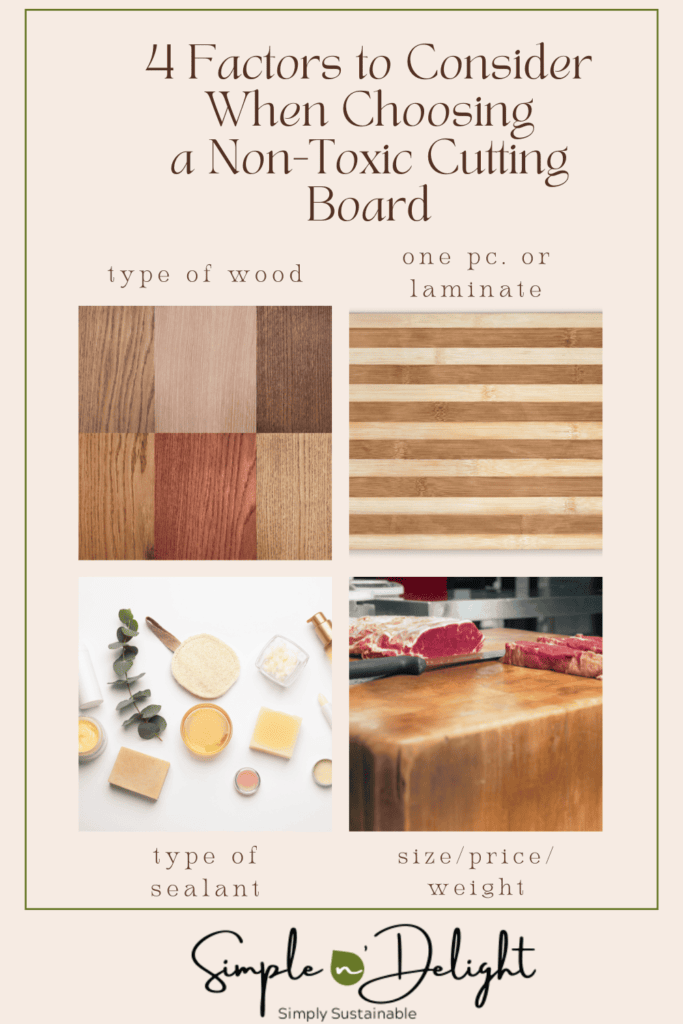
When choosing a non-toxic cutting board, there are several important factors to consider to ensure the safety and quality of your kitchen tool.
- Type of Wood
- One-piece or Laminate
- Type of Oil Used to Seal and Condition the Wood
- Size, Price, Weight
Firstly, the type of wood is crucial. Ensure the wood is untreated and free from toxic chemicals or finishes. Choosing wood based on hardness can also help keep your board looking sharper and newer for longer.
Sustainable harvesting is also something to consider. Companies that plant a tree for every board sold are one-step to a greener planet and also often care about the health and experience of the customers.
For laminated cutting boards, which are cutting boards that are glued together to form one large piece of wood, it’s important to consider the adhesive or glue used. Look for cutting boards made with food-safe and non-toxic adhesives that are specifically designed for culinary applications. This ensures that no harmful substances will leach into your food during use. The most reputable companies will disclose the use of non-toxic, formaldehyde-free adhesives.
Additionally, consider the finishing products applied to the surface of the cutting board. Some finishes may contain toxic chemicals that can transfer to your food. Choose finishes that are food-safe and free from harmful substances like volatile organic compounds (VOCs). Mineral Oil is food safe, yet is derived from fossil fuels and is not environmentally friendly. Better oils for board conditioning include beeswax, avocado oil, linseed oil and coconut oil.
It is also important to factor into consideration the weight since it is important to wash it properly after use, and only you will be the judge of how heavy it is to bring to the sink, dry it properly, and replace it to its proper place.
By taking these factors into account when choosing a non-toxic cutting board, you can create a safe and healthy kitchen environment while enjoying the benefits of a high-quality and long-lasting culinary tool.
“What about plastic cutting boards?”
Why Wood is the Better Choice for a Non-Toxic Cutting Board
Wood is a superior choice over plastic when it comes to cutting boards for several reasons. Firstly, wood is a natural material that has inherent antimicrobial properties. Studies have shown that wood possesses the ability to inhibit the growth and survival of bacteria, making it a more hygienic option for food preparation. In contrast, plastic cutting boards can develop deep knife grooves where bacteria can thrive, even with regular cleaning.
Furthermore, wood is gentler on knife blades, reducing the risk of dulling or damaging them compared to plastic boards. Wood’s natural resilience and self-healing properties allow it to withstand repeated knife strikes without leaving deep marks, maintaining the integrity of the cutting surface for longer.
Another advantage of wood cutting boards is their aesthetic appeal. Wood’s warm tones and natural grain patterns add a touch of elegance and warmth to any kitchen. Plastic boards, on the other hand, often appear utilitarian and lack the natural beauty that wood provides.
In terms of sustainability, wood can be a more environmentally friendly choice. By opting for cutting boards made from sustainably sourced wood, we support responsible forestry practices and reduce our reliance on petroleum-based plastic products. Additionally, at the end of their life cycle, wood cutting boards can be recycled or even composted, making them a more sustainable choice compared to non-recyclable plastic boards that contribute to landfill waste.
Click here to jump to our section how best to maintain your non-toxic cutting board.
Our Top Picks for Non-Toxic Cutting Boards
Maple Non-Toxic Cutting Board #1: John Boos
Made in the USA, this non-toxic cutting board will last you for years. Made from sustainably sourced maple, it is reversible and is the perfect thickness to be both sturdy and manageable for cleaning and moving. It is a laminate board that comes pre-treated with a food-safe natural oil finish. Make sure to buy the mystery oil or your oil of choice to treat the board monthly for longevity and function.
Best Features:
- Edge Grain Maple Wood
- Medium Size
- Pre-treated
- Made in USA
(Back to List)
Maple Non-Toxic Cutting Board #2: Wood for Chef
With the choice of three sizes, this pre-treated cutting board is another great option as a non-toxic cutting board. Wood for Chef is not only climate pledge friendly, but it also uses a mixture of beeswax and food safe mineral oil. This edge-grain cutting board has convenient juice-grooves keeping your kitchen cleaner. In order to keep it preserved, make sure to wax it with your choice of oil, or this plant-based oil which does the trick!
Best Features:
- Edge Grain Maple Wood
- Three sizes to choose from
- Pre-treated
- Made in USA
(Back to List)
Maple Non-Toxic Cutting Board #3: Boomer Creek
This the perfect cutting board for a small kitchen and budget oriented individuals. Hand-made and unfinished, this non-toxic cutting board is great for those of you who are trying to avoid mineral oil since you can apply the wax of your choice once you receive it. We recommend a natural oil that doesn’t go rancid, such as beeswax or coconut oil.
Best Features:
- One-piece solid wood cutting board no glue
- Small
- Handle
- Unfinished
- Made in Canada
(Back to List)
Teak Non-Toxic Cutting Board #1: Sonder
Sonder is a reputable company making non-toxic cutting boards out of LA. This teak board is a great addition to any kitchen. With juice grooves and sturdy water resistant teak wood, this is a quality non-toxic cutting board which will last you years to come. The board is heavy enough to prevent it from moving around when in use, but light enough to clean easily. You will not be disappointed by this board! Grab some food safe mineral oil or plant based oil to maintain this board every 3 weeks.
Best Features:
- Edge Grain Teak
- 23″L x 17″W x 1.5″ Thickness
- Pre-treated with Food Safe Mineral Oil
- Made in USA
(Back to List)
Teak Non-Toxic Cutting Board #2: Shumaru
Shumaru makes beautiful non-toxic cutting boards out of both the end-grain and the edge-grain teak wood. This end grain board is not only stunning, it is self-healing will show knife cuts less obviously than an edge-grain board would. We especially liked this board since it pre-treated with ONLY plant-based food safe oil, from palm and rapeseed.
Best Features:
- End Grain Teak Wood
- 20″L x 15″W x 1.5″T
- Pre-treated with Plant-Based Oil
- Handles and Juice Grooves
(Back to List)
Teak Non-Toxic Cutting Board #3: United Wooden Bali
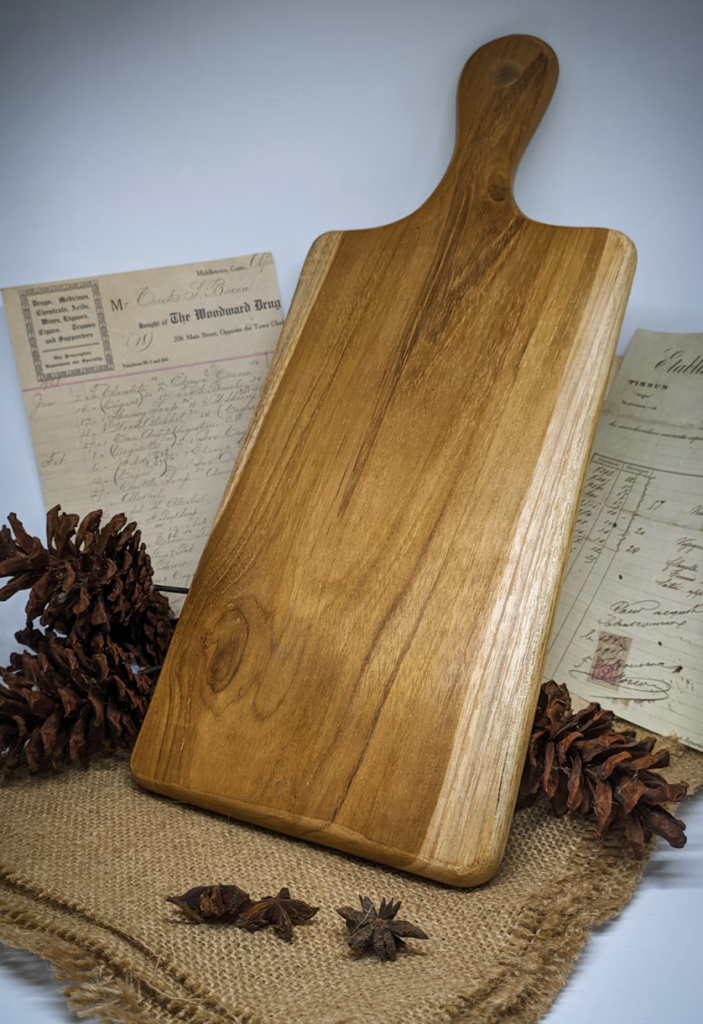
This niche non-toxic cutting board is made in Bali out of a single piece of teak wood. If you’re looking to avoid glues, this is the board for you. Small and portable, this cutting board is easy to store, clean, and lift to the pan.
Best Features:
- One-piece teak solid wood cutting board no glue
- Edge Grain
- 33cm x 19cm
- Pre-treated with Food-safe Oil
(Back to List)
Walnut Non-Toxic Cutting Board #1: Sonderla Alfred Cutting Board
Made from black walnut and end grain wood, this non-toxic cutting is elegance at its best. With carved out juice grooves on one side and 3 built-in compartments on the other, this cutting board is the sought-after choice for chefs. It comes pre-treated with non-toxic food safe mineral oil, yet will require upkeep with either mineral oil or beeswax.
Best Features:
- End Grain Black Walnut
- 17 x 13 x 1.5’’
- Pre-treated with Mineral Oil
- Compartments and Juice Grooves
(Back to List)
Walnut Non-Toxic Cutting Board #2: Virginia Boys Kitchen
This non-toxic cutting board from Virginia Boys Kitchen (VBK) is not only a great safe option for your kitchen, but also for the planet. VBK plants a tree for every cutting board sold, but this is not the only reason to buy this quality cutting board. The juice grooves, quality of construction, and the large working surface make this a perfect cutting board for anyone that enjoys dark wood. This cutting board is great for those that want a lighter board to carry to the pan and sink since the thickness is half that of other boards.
Best Features:
- Laminate walnut
- End Grain
- 17″L x 11″W x 0.75″Th
- Pre-treated with Coconut and Essential Oils
- Juice Grooves
- Lighter Weight
(Back to List)
Walnut Non-Toxic Cutting Board #3: Grain Woods
Grain Woods makes a beautiful end-grain cutting board from European Walnut. We love so many things about these boards: the choice of sizes, the juice groove, the custom engraving, and the pre-treated application of plant-based oils and beeswax. Blades stay sharper longer with end-grain boards, and grooves are not as easily seen. This board is a winner and makes a great wedding present.
Best Features:
- End Grain European Walnut
- 20″L x 15″W x 1.5″T
- Pre-treated with Plant-Based Oil and Beeswax
- Handles and Juice Grooves
(Back to List)
Cherry Non-Toxic Cutting Board #1: John Boos
We include John Boos in our list again because of the quality workmanship that this company has been perfecting since 1887. This edge-grain non-toxic cutting board is a beautiful edition to any kitchen. From four sizes to choose from, this cutting boards can either be a perfect presentation piece that sits on your counter for daily use, or easily stored away.
Best Features:
- Edge Grain Cherry Wood
- 20″L x 15″W x 1.5″T
- Pre-treated with Food-Safe Mineral Oil
- Handles
(Back to List)
Cherry Non-Toxic Cutting Board #2: YD Woodshop
YD Woodshop makes beautiful one-piece cherry wood non-toxic cutting boards. With the one-piece construction there are no joints or glue and every unique board shows different grains and patterns. As a 1 inch thick board, it is easily stored away when not in use. Veteran owned and made in the USA, when you buy this board you are supporting local business.
Best Features:
- One-piece Cherry solid wood cutting board no glue
- 3 sizes to choose from
- Veteran Owned from Texas
- Pre-conditioned with mineral and beeswax
- Juice Grooves
(Back to List)
Cherry Non-Toxic Cutting Board #3: Heirloom Crafts n’ Canes
This is another unique non-toxic cutting board that is made from a single piece of wood, with no glues or sealants. Also finished with beeswax only, this cutting board has bevelled edges for easy handling and smooth aesthetically pleasing edges. Guaranteed to last a long time with consistent upkeep.
Best Features:
- One-piece Cherry solid wood cutting board no glue
- 8 by 12 inches
- Pre-treated with beeswax
- Bevelled edges and smoothed corners
(Back to List)
Bamboo Non-Toxic Cutting Board #1: Slice Bright
Royal craft is not only a great non-toxic option for bamboo cutting boards, but they also have large, XL, XXL sizes to choose from. Bamboo has a unique look with its varied layers and lighter wood. Also a lighter weighing wood than others, these bamboo non-toxic cutting boards are easy to bring to and from the sink or pan for easy maneuverability.
Best Features:
- 3 sizes of Bamboo Cutting Boards
- Juice Grooves and Handles
- Bamboo is a very sustainable crop
- Handles and Juice Grooves
(Back to List)
Bamboo Non-Toxic Cutting Board #2: Greener Chef
For those of you looking for the most value driven non-toxic cutting board, this is it. With an extra large surface for cutting, this organic cutting board is a great lightweight and comes with a lifetime warranty. Make sure to treat it regularly and wash by hand to keep it in good condition.
Best Features:
- Large organic Bamboo Surface
- 17.9″L x 12.5″W x 0.7″Th
- Lifetime Warranty
- Juice Grooves
- Lightweight
(Back to List)
Bamboo Non-Toxic Cutting Board #3: Hiware
This extra-large organic cutting board is another great value purchase. This Hiware non-toxic cutting board is made for food prep or food presentation alike. Slightly thicker than other bamboo cutting boards that you will find on the market, the Hiware board is still lightweight for easy cleaning and handling.
Best Features:
- Organic Bamboo
- Value Buy
- 18″L x 12″W x 0.8″Th
- Lightweight
- Handles and Juice Grooves
(Back to List)
Maintaining Your Non-Toxic Cutting Board
Taking proper care of your non-toxic cutting board is essential to ensure its longevity, hygiene, and performance. Follow these maintenance tips to keep your cutting board in optimal condition:
- Cleaning: After each use, wash your cutting board with hot, soapy water. Use a mild dish soap and a non-abrasive sponge or cloth to remove any food particles or residue. Avoid submerging the board in water or soaking it, as excessive moisture can lead to warping or cracking. Rinse the board thoroughly and dry it with a clean towel or allow it to air dry upright.
- Sanitizing: To maintain a hygienic cutting surface, periodically sanitize your board. You can use a solution of one part vinegar to five parts water or a mixture of hydrogen peroxide and water. Apply the solution to the cutting board, let it sit for a few minutes, then rinse and dry the board thoroughly.
- Removing Stains and Odors: For stubborn stains or lingering odors, sprinkle coarse salt or baking soda on the board, then scrub gently with a lemon half or a soft brush. Rinse the board well and dry it completely.
- Oiling: Regularly applying a food-safe oil to your cutting board helps nourish the wood, maintain its moisture balance, and protect it from drying out or absorbing excess moisture. Use food-grade mineral oil, coconut oil, or beeswax-based products specifically designed for cutting boards. Apply a thin, even coat of oil to the entire surface of the board, allowing it to penetrate the wood for a few hours or overnight. Wipe off any excess oil before using the board.
- Avoiding Harsh Cleaners and Materials: Refrain from using harsh cleaners, bleach, or abrasive scouring pads on your cutting board, as these can damage the surface or remove the protective finish. Also, avoid exposing the board to extreme temperatures, such as placing it in the dishwasher or subjecting it to direct sunlight or excessive heat.
- Proper Storage: Store your cutting board in a dry and well-ventilated area. Avoid stacking or leaning cutting boards against each other, as this can trap moisture and promote the growth of bacteria.
By following these maintenance practices, you can ensure that your non-toxic cutting board remains safe, hygienic, and in excellent condition for years to come.
Conclusion
In conclusion, it is evident that making conscious choices about the products we use in our daily lives can significantly contribute to our overall well-being. From opting for plastic-free coffee makers for a healthier brewing experience to investing in non-toxic air fryers for safe cooking, and even selecting non-toxic shower curtains/liners to reduce exposure to harmful substances, there are numerous ways to create a safer environment for ourselves and our loved ones.
If you’re interested in exploring plastic-free coffee makers, you may find the article “Staying Clean: The Best Plastic-Free Coffee Makers for Healthy Brewing” informative. It provides insights into various options available in the market and their benefits for promoting a healthier lifestyle.
For those who prioritize safe cooking practices, “Cooking Safely: The Best Non-Toxic Air Fryers of 2023” offers valuable guidance on selecting air fryers that are free from harmful chemicals. This article highlights the top models in 2023 that prioritize both cooking efficiency and consumer health.
Additionally, if you’re looking to reduce your exposure to toxins in the bathroom, “The Best Non-Toxic Shower Curtains/Liners to Reduce Your Exposure” is an excellent resource. It explores different shower curtain and liner options that are designed with non-toxic materials, helping you create a safer bathing environment.
By incorporating these recommendations and considering other non-toxic alternatives for everyday products, we can make a positive impact on our well-being and contribute to a healthier and more sustainable future.

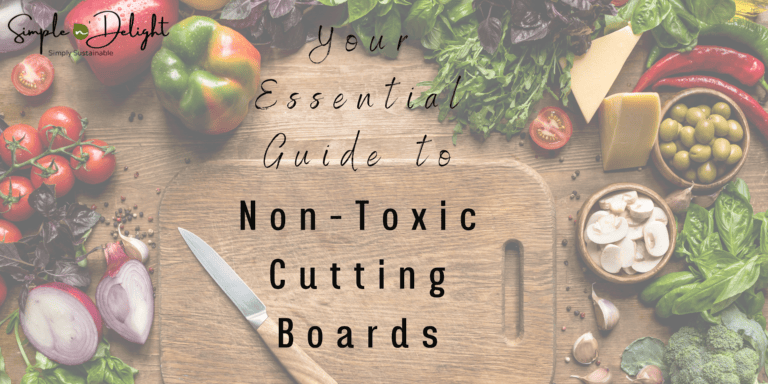



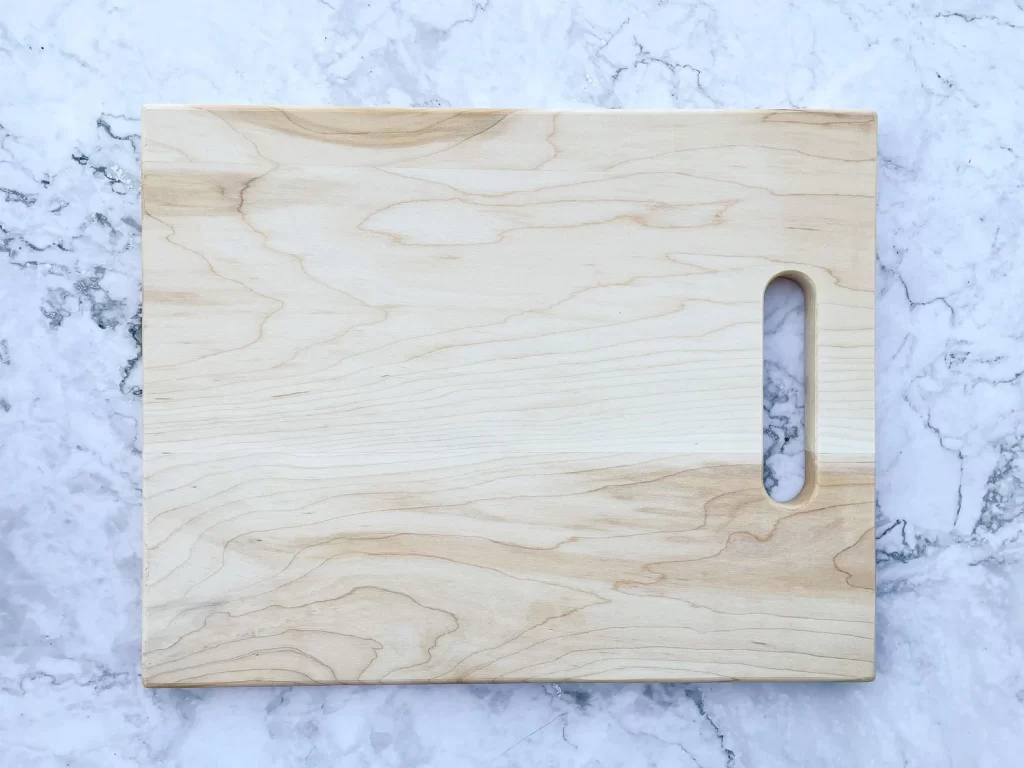


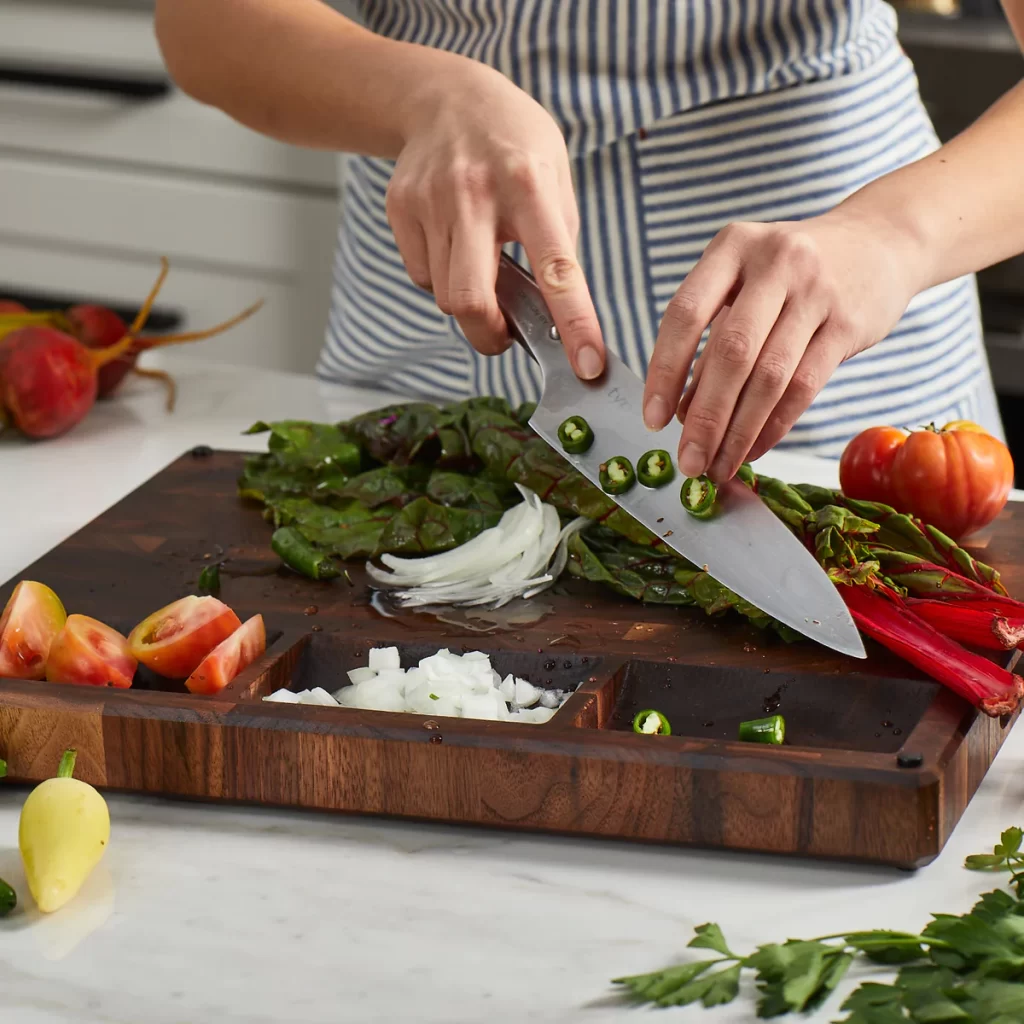

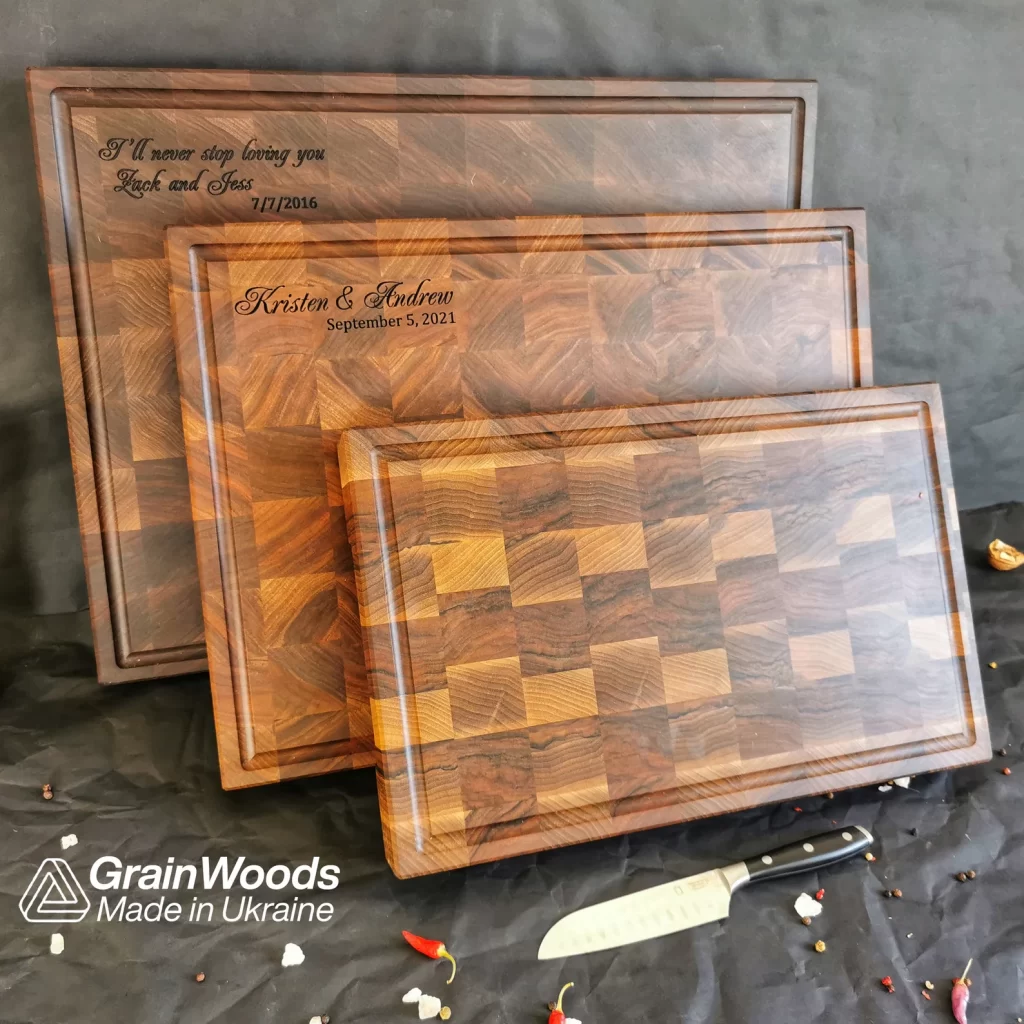

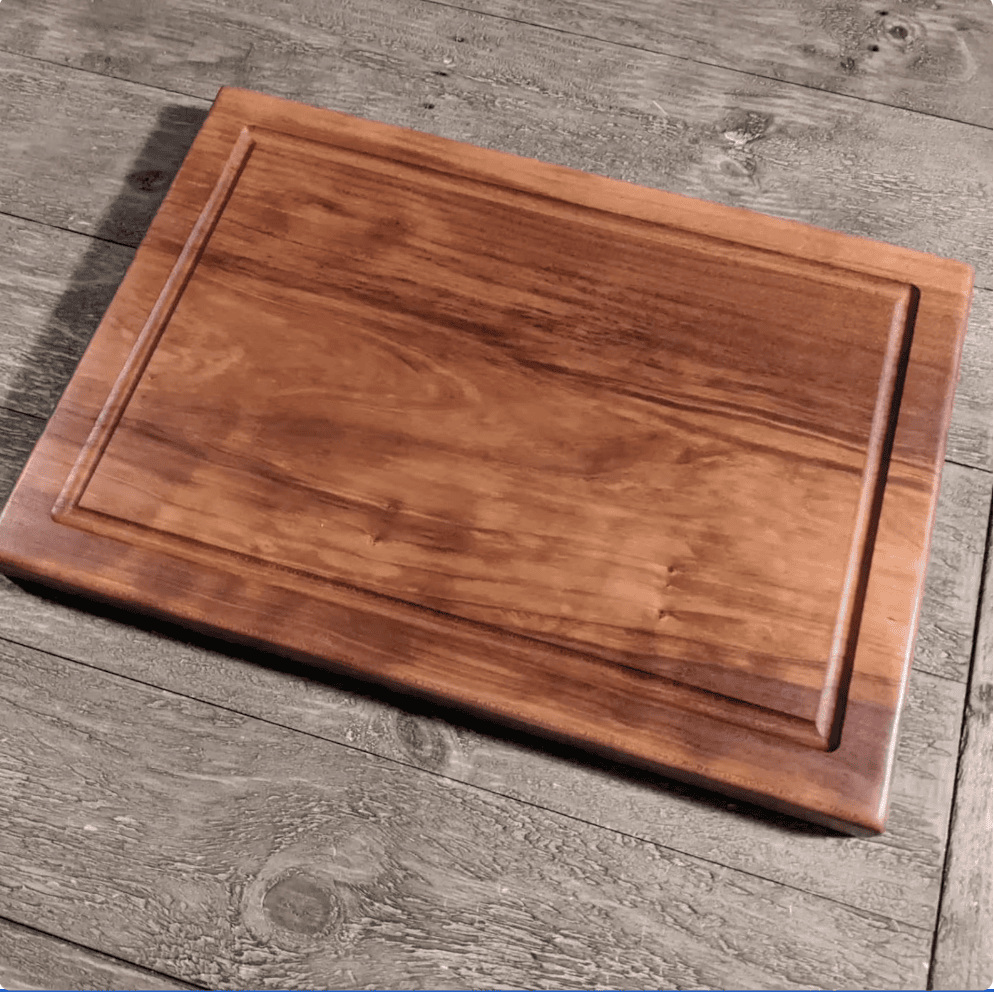
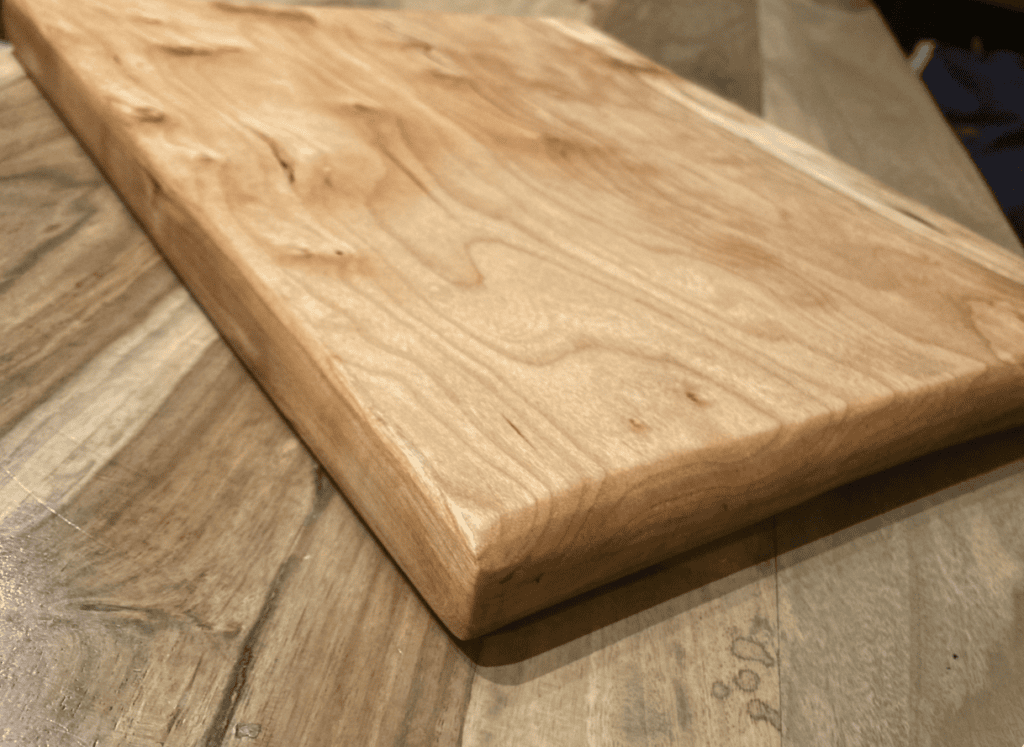



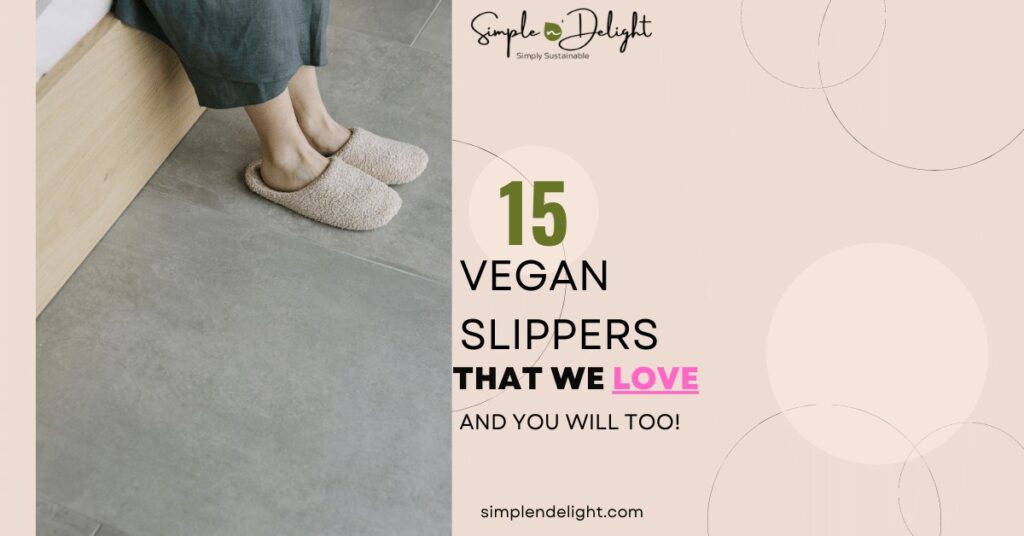
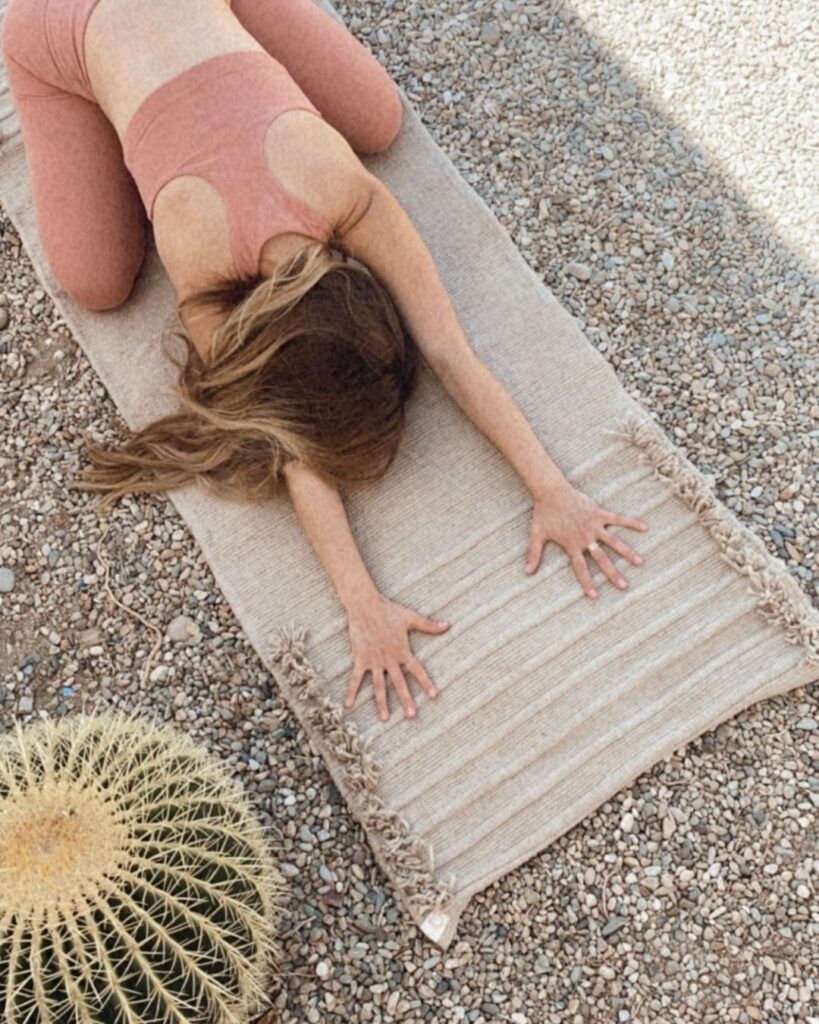

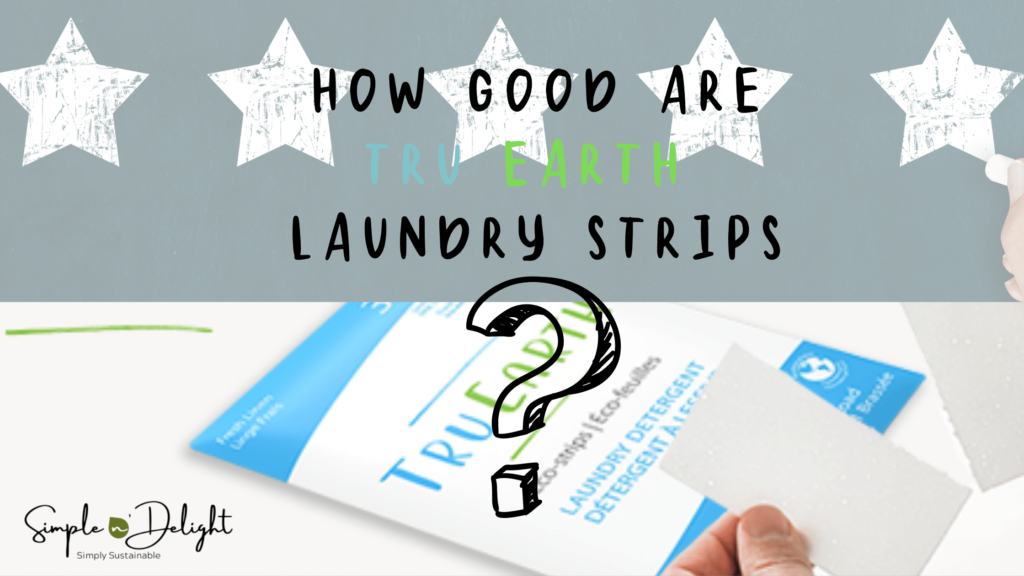

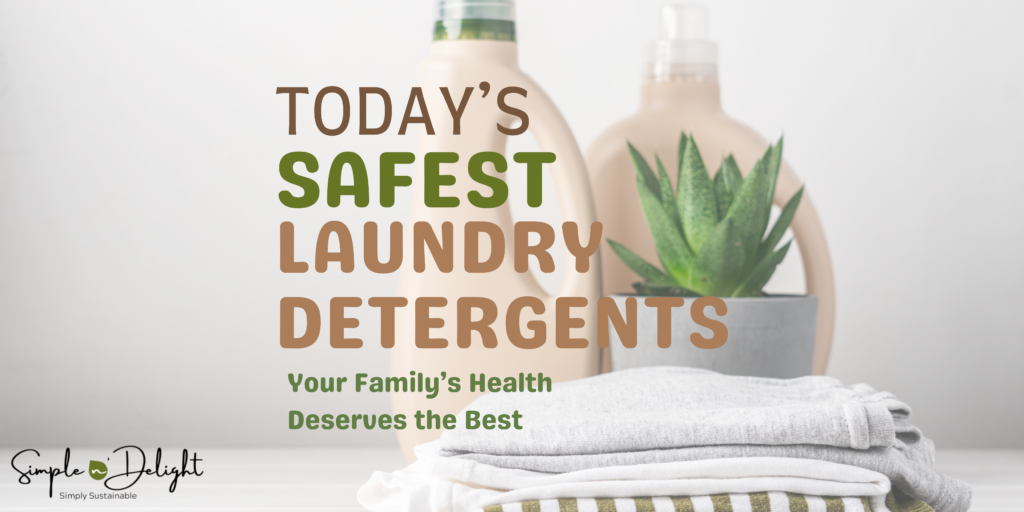
5 Responses
Great job!
A wonderful and thorough article. Thank you!
These are all amazing non-toxic cutting board ideas. Thanks for sharing!
Wow! This is the info I didn’t know I needed concerning plastic boards and bacteria! Always thought they were safer. The Hand-Crafted cherry one is my choice.
This was really helpful, because I was actually looking to switch out to more non-toxic items a little bit at a time. I was really grateful you added in how to wash and care for them because as I was reading, that was the question going through my mind. I will be referring back to this article in the future.